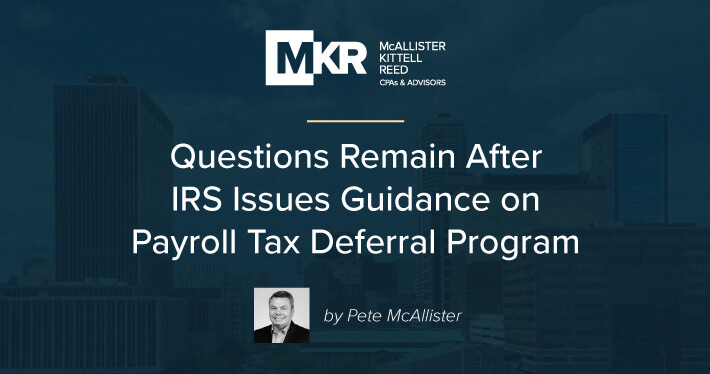In general, the likelihood of an IRS tax audit for a small business is slim, but there are various factors that can greatly increase the chances of being targeted. The IRS checks for a range of red flags to pinpoint businesses that are more likely to have...
MKR Blog

Small Business Owners Should Avoid These Common Tax Audit Triggers
The IRS uses a computer program called the Discriminant Function System (DIF) to analyze tax returns and red flag them if they deviate from statistical averages. When a return draws a high DIF score, an agent evaluates it and decides if an audit is necessary. Your...

Questions Remain After IRS Issues Guidance on Payroll Tax Deferral Program
On Aug. 28, 2020, as part of COVID-19 relief, President Trump issued a presidential memorandum allowing employers to suspend withholding and paying to the IRS eligible employees’ Social Security payroll taxes from September 1, 2020 through December 31, 2020. The IRS...

COVID-19 Stimulus Checks: Who Qualifies and What to Expect
The U.S. Government has already started sending stimulus payments to Americans from the $2 trillion coronavirus stimulus bill known as the Coronavirus Aid, Relief, and Economic Security (CARES) Act, which was signed into law on March 27, 2020. But there is still some...

The CARES Act and Small Business Loan Assistance
On March 27 the CARES Act was signed into law in response to the COVID-19 pandemic. Below is an overview of the types of assistance available to small businesses in an effort to lessen some of the economic impact. Paycheck Protection Program (PPP) Loan This is a $350...

Smart Moves to Make with Your Tax Refund
Whether you’re working with a robust tax refund, a work bonus, or an inheritance of some kind, here’s a list of positive moves to make with that windfall. Evaluate Your Debt There’s “bad” debt and “good” debt. Good debt is an investment that will grow in value or...

Taxes You Could Face in Retirement
As an American worker, relinquishing part of your income to taxes is standard practice, but once you move out of the workforce, much of your retirement income is subject to taxes as well. Below are some possible taxes you could face in retirement. Social Security...

How to Prevent Tax Identity Theft
The start of a new year is a time for fresh starts and new goals, but it’s also the beginning of the oft-dreaded tax season, which means Tax identity thieves are on the lookout for information they can use in order to create fraudulent tax returns. Here are some tips...

How the Tax Cuts and Jobs Act Affects Year-End Business Tax Planning
With the learning curve of the first tax filing season in the TCJA era behind us, year-end tax planning is a perfect time to incorporate those lessons learned. Here is a general overview of some steps business owners can take in their year-end tax planning....

Tips for Year-End Business Tax Planning
With additional guidance and regulations released consistently since President Trump signed the Tax Cuts and Jobs Act of 2017 into law, one thing remains clear: strategic tax planning is key to lowering a business’s total tax liability. Read on for some moves on...
Missed Quarterly Tax Payments? How to Avoid Penalties and Fix Your Situation Now
If you're self-employed or earn income without tax withholding, you’re likely required to pay quarterly estimated taxes. Missing these payments can result in penalties and interest charges from the IRS, but don’t panic—you have options to correct the situation and...
Smart Ways to Use Your Tax Refund: Boost Savings, Pay off Debt, and Strengthen Your Finances
What you choose to do with your tax refund can significantly impact your long-term financial health. Instead of splurging, consider using this extra cash to strengthen your finances. Smart strategies, such as building an emergency fund, paying off high-interest debt,...
Retirees Need to Know About These Major Updates to Medicare in 2025
Medicare is undergoing significant changes in 2025, impacting costs, prescription drug coverage, telehealth access, and caregiver support. Retirees should prepare for these updates to manage their healthcare expenses effectively. Below, we break down the key Medicare...
Retailers Shift from Layoffs to Optimization: How Efficiency Investments are Reshaping Retail in 2025
After a period of workforce reductions and aggressive cost-cutting measures, major retail companies are shifting toward optimization strategies—investing in technology, process improvements, and operational efficiencies that enhance productivity without sacrificing...
How Trump’s Tariffs Could Impact U.S. Consumers
The Trump administration’s tariffs on key trading partners, including Canada, Mexico, and China, could have far-reaching consequences for U.S. consumers. With a 25% tariff on Canadian and Mexican goods, a 10% tariff on Chinese imports, and a lower 10% tariff on...
Top Veterinary Medicine Trends to Watch in 2025 and Their Impact on the Industry
As veterinary medicine continues to evolve, 2025 promises to be a transformative year. Industry professionals face emerging legislation, possible new roles, energized investor interest, and shifting dynamics in the pet insurance market. Here are the top trends shaping...
Tax Season 2025: Filing Deadline and Other Due Dates to Know
Tax season 2025 is here, and staying on top of important deadlines is essential for avoiding late fees and penalties. Knowing key dates like the federal income tax filing deadline, quarterly estimated tax payment due dates, and extensions can help you stay organized...
Proven Strategies to Set Your Small Business Up for Success in 2025
Running a small business in 2025 presents both challenges and opportunities. To stay ahead of the competition, you must adopt a proactive approach to planning and execution. By focusing on the following strategies, you can set your business up for success this year...
How Construction Firms Can Break Through Progress Barriers for Growth and Greater Profits
For construction companies, growth and profitability often hinge on that company’s ability to overcome progress barriers. Whether it’s delays in project timelines, inefficiencies in communication, or outdated practices, construction firms need innovative solutions to...
How Trump’s Second Term Could Impact Your Taxes
After Donald Trump’s win in November, taxpayers are wondering how a second Trump term could reshape U.S. tax policy. Trump’s first term saw sweeping changes under the Tax Cuts and Jobs Act (TCJA) of 2017. With key provisions of that legislation set to expire in 2025,...
